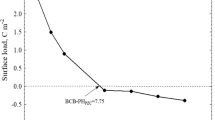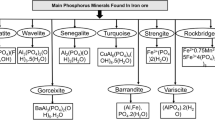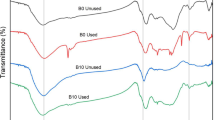Abstract
Aluminum electrolyte is a necessity for aluminum reduction cells; however, its stock is rising every year due to several factors, resulting in the accumulation of solid waste. Currently, it has become a favorable material for the resources of lithium, potassium, and fluoride. In this study, the calcification roasting–two-stage leaching process was introduced to extract lithium and potassium separately from aluminum electrolyte wastes, and the fluoride in the form of CaF2 was recycled. The separation behaviors of lithium and potassium under different conditions were investigated systematically. XRD and SEM–EDS were used to elucidate the phase evolution of the whole process. During calcification roasting-water leaching, the extraction efficiency of potassium was 98.7% under the most suitable roasting parameters, at which the lithium extraction efficiency was 6.6%. The mechanism analysis indicates that CaO combines with fluoride to form CaF2, while Li-containing and K-containing fluorides were transformed into water-insoluble LiAlO2 phase and water-soluble KAlO2 phase, respectively, thereby achieving the separation of two elements by water leaching. In the second acid-leaching stage, the extraction efficiency of lithium was 98.8% from water-leached residue under the most suitable leaching conditions, and CaF2 was obtained with a purity of 98.1%. The present process can provide an environmentally friendly and promising method to recycle aluminum electrolyte wastes and achieve resource utilization.












Similar content being viewed by others
Data availability
The datasets used and analyzed during the current study are available from the corresponding author on reasonable request.
References
Bhatnagara A, Kumara E, Sillanpääb M (2011) Fluoride removal from water by adsorption—a review. Chem Eng J 171:811–840. https://doi.org/10.1016/j.cej.2011.05.028
Cao SY, Liu JN, Chang JL, Huang JD, Cheng Y (2019) Asynchronous separation of aluminum, potassium and sodium from acid leaching solution of potash feldspar alkalized roasting slag. Min Metall 28:58–62. https://doi.org/10.3969/j.issn.1005-7854.2019.01.013
Chen WJ, Wang W, Zhu G (2020) Effect of potassium salt on properties of carbon cathode materials for aluminum electrolysis. J Henan Univ Sci Technol (Nat Sci) 41:8–12. https://doi.org/10.15926/j.cnki.issn1672-6871.2020.05.002
Chen BX, Peng JP, Wang YW, Di YZ (2022) Penetration behavior of electrolyte into graphite cathode in NaF-KF-LiF-AlF3 system with low cryolite ratios. Trans Nonferr Metals Soc China 32:2727–2735
Fan J, Ruan FX (2002) Review on the extracting methods of aluminum from powdered calcium aluminate. Appl Chem Ind 1:1−3. https://doi.org/10.16581/j.cnki.issn1671-3206.2002.01.001
Gao BL, He F, Li G, Wen SY, Liu AM, Wang ZW (2020) Effect of bath composition on aluminum electrolysis process. China Light Metals, pp 17−23. https://doi.org/10.13662/j.cnki.qjs.2020.12.005
Han W (2021) Impact of high-lithium electrolyte on aluminum electrolysis production and improvement measures. China Steel Focus, 11: 40−41
Heng ML (2019) Discussion on process conditions control of aluminum reduction cell in complex electrolyte system. China Light Metals, pp 29−32. https://doi.org/10.13662/j.cnki.qjs.2019.07.006
Hou JF, Wang ZW, Li TF, Shi ZN, Hu XW (2016) Elimination of lithium from aluminium electrolyte by acid leaching method. In: Williams E (ed) Light Metals 2016, pp 353–357. https://doi.org/10.1007/978-3-319-48251-4_58
Huan SX, Wang YW, Di YZ, You J, Peng JP, Hong YM (2020) Experimental study on alumina extraction by calcination of secondary aluminum ash. Conserv Utilization Mineral Resour 40:34–39. https://doi.org/10.13779/j.cnki.issn1001-0076.2020.07.005
Huang LQ, Liu ZW, Yan HW, Qin B, Liu YX (2020) Research status on the low temperature electrolyte system for aluminum electrolysis. Nonferr Metals Eng 10:42–48. https://doi.org/10.3969/j.issn.2095-1744.2020.06.007
Islam M, Patel RK (2007) Evaluation of removal efficiency of fluoride from aqueous solution using quick lime. J Hazard Mater 143:303–310. https://doi.org/10.1016/j.jhazmat.2006.09.030
Jiang K, Zhou KG, Yang YC, Du H (2013) A pilot-scale study of cryolite precipitation from high fluoride-containing wastewater in a reaction-separation integrated reactor. J Environ Sci 25:1331–1337. https://doi.org/10.1016/S1001-0742(12)60204-6
Kotte JJ (1981) Bayer digestion and predigestion desilication reactor design. In: Donaldson D, Raahauge BE (eds) Essential Readings in Light Metals, pp 516−518. https://doi.org/10.1007/978-3-319-48176-0_45
Lei SM, Guo ZH (2012) Hazards of fluoride pollution and technical research progress of treating fluoride-containing wastewater. Metal Mine 4:152–155
Li J, Fang Z, Lai YQ, Lv XJ, Tian ZL (2009) Electrolysis expansion performance of semigraphitic cathode in [K3AlF6/Na3AlF6]-AlF3-Al2O3 bath system. J Cent South Univ Technol 16:422–428
Li CH, Cao AL (2020) Effects of lithium and potassium salts on alumina concentration in complex aluminum electrolyte system. Nonferr Metals (Extractive Metall) 37–42. https://doi.org/10.3969/j.issn.1007-7545.2020.06.007
Liu FQ, Li AJ, Li RB, Yang X, Wu ZG (2021) Study on recovery and utilization of multiple elements in aluminum electrolyte by calcified roasting. Nonferr Metals (Extractive Metall) 2:67–71+122. https://doi.org/10.3969/j.issn.1007-7545.2021.02.010
Ma Q (2017) Production practice of aluminum reduction cell in complex electrolyte. World Nonferr Metal 14:69–72
Ma SC, Yang ZC, Wang QY (1988) The dictionary of inorganic compounds. Shaanxi Science and Technology Press, Shaanxi
Tanvar H, Dhawan N (2022) Kinetic and thermodynamic study of potassium recovery from silicate rocks. Min Proc Ext Met-UK 131:1–13. https://doi.org/10.1080/25726641.2019.1699360
Tao WJ, Yang JX, Chen LY, Zhang YF, Wu SH, Li JM, Liu ZS, He JG, Wang ZW (2023a) Environmentally friendly and efficient green recovery of fluoride from waste aluminum electrolytic sediment using Al2O3. Sep Purif Technol 317:123934. https://doi.org/10.1016/j.seppur.2023.123934
Tao WJ, Yang JX, Chen LY, Zhang YF, Wu SH, Li JM, Liu ZS, He JG, Wang ZW (2023b) Sustainable recovery of fluorine from waste aluminum electrolyte by sulfuric acid baking. J Suatain Metall 9:1201–1214. https://doi.org/10.1007/s40831-023-00719-9
Tarcy GP, Kvande H, Tabereaux A (2011) Advancing the industrial aluminum process: 20th century breakthrough inventions and developments. JOM 63:101–108. https://doi.org/10.1007/s11837-011-0120-4
Wang Y, Jiang Y, Jiang CN, Cao RB, Geng XZ, Pan XL (2020b) Phase transformation behavior of calcium-bearing minerals in high-alumina fly ash. Nonferr Metals (extractive Metall) 3:85–90
Wang JP, Ye JM, Lin LF, Wang YQ (2020c) Study on the process of extracting lithium technology from electrolytic aluminum waste slag. Henan Chem Ind 1:36–39. https://doi.org/10.14173/j.cnki.hnhg.2020.01.010
Wang GG, Chen CY, Li JQ, Lin X, Zhang HB (2024) A zero-emission collaborative treatment method for brown corundum fly ash and carbide slag: producing silicon fertilizer while recovering gallium and potassium. Sep Purif Technol 332:125739. https://doi.org/10.1016/j.seppur.2023.125739
Wang XY, Zhang RZ, Yang SL, Liu BS (2020a) Studying on the process mineralogy and existing state of lithium in bauxite ore from Mianchi district, Henan province. Multipurpose Utilization of Mineral Resources, 6:163–170
Wei XL, Gao WJ, Wang YM, Wu K, Xu TW (2022) A green and economical method for preparing lithium hydroxide from lithium phosphate. Sep Purif Technol 280:119909. https://doi.org/10.1016/j.seppur.2021.119909
Wen J, Jiang T, Zhou M, Gao HY, Liu JY, Xue XX (2018) Roasting and leaching behaviors of vanadium and chromium in calcification roasting–acid leaching of high-chromium vanadium slag. Int J Miner Metall Mater 25:515–526. https://doi.org/10.1007/s12613-018-1598-3
Wu SH, Tao WJ, Zheng YC, Yang YJ, Yu JY, Cui JB, Lu Y, Shi ZN, Wang ZW (2020) Novel process for the extraction of lithium carbonate from spent lithium containing aluminum electrolytes by leaching with aluminum nitrate and nitric acid. Hydrometallurgy 198:105505. https://doi.org/10.1016/j.hydromet.2020.105505
Wu SH, Tao WJ, Zheng YC, Ge H, He JG, Yang YJ, Wang ZW (2021) A novel approach for lithium recovery from waste lithium-containing aluminum electrolyte by a roasting-leaching process. Waste Mange 134:89–99. https://doi.org/10.1016/j.wasman.2021.08.011
Xu WD (2017) Analysis of low-temperature production control technology of high lithium salt electrolyte system. China Nonferr Metals S1:317–321
Xu R, Luo S, Li WZ, Zhang CY, Chen ZH, Wang Y, Liu Y, Li J (2023) Clean process for selective recovery of lithium carbonate from waste lithium-bearing aluminum electrolyte slag. Ind Eng Chem Res 62:14111–14754. https://doi.org/10.1021/acs.iecr.3c01838
Yang YJ, Hu XW, Wang ZW, Yasinskiy A, Polyakov P, Shi ZN (2020a) Potassium balance and its distribution in commercial aluminum reduction cells—when potassium-containing alumina is used as the raw material for aluminum electrolysis. Electrochemistry 88:574–579. https://doi.org/10.5796/electrochemistry.20-00093
Yang ZM, Lv ZY, Pan XL, Yu HY (2020b) Extraction of alumina from desiliconized fly ash by low-calcium lime sinter process. Nonferr Metals (Extractive Metall) 9:64–68+96
Yang Y, Chen HY, Li YK, Fan ZL, Li GX, Duan ZQ, Zhao Y, Wang DL (2023) Progress of process development and industrial application for anhydrous hydrogen fluoride and aluminum fluoride. Inorg Chem Ind 55:17–25+120. https://doi.org/10.19964/j.issn.1006-4990.2022-0649
Yelatontsev D, Mukhachev A (2021) Processing of lithium ores: industrial technologies and case studies – a review. Hydrometallurgy 201:105578. https://doi.org/10.1016/j.hydromet.2021.105578
Zeng GS, Ling B, Li ZJ, Luo SL, Sui XZ, Guan Q (2019) Fluorine removal and calcium fluoride recovery from rare-earth smelting wastewater using fluidized bed crystallization process. J Hazard Mater 373:313–320. https://doi.org/10.1016/j.jhazmat.2019.03.050
Zhang YH, Zhai XJ, Wang YW, Peng JP, Li BC, Feng NX (2011) Penetration of electrolyte containing KF and LiF into graphite cathode during aluminum electrolysis. Chin J Process Eng 11:755–760
Zhao H, Wang Y, Cheng HF (2023) Recent advances in lithium extraction from lithium-bearing clay minerals. Hydrometallurgy 217:106025. https://doi.org/10.1016/j.hydromet.2023.106025
Funding
This research work was financially supported by the National Natural Science Foundation of China (Grant numbers 51874086, 51804071, 51904192, 51434005, 51529401, 51804069, 51804070); the Fundamental Research Funds for the Central Universities (Grant number N2025024); the Liaoning Natural Science Foundation (Grant number 2022-MS-121); and the Ministry of Education—Weiqiao industrial program (Grant number 2021021800101).
Author information
Authors and Affiliations
Contributions
Shaohua Wu: conceptualization, investigation, methodology, writing—original draft. Wenju Tao: writing—review and editing, supervision, validation, formal analysis, visualization. Hui Ge: conceptualization, writing—review and editing, formal analysis, data curation. Jiaxin Yang, Jiaming Li, **gui He, and Youjian Yang: investigation, methodology, writing—review and editing, formal analysis. Zhaowen Wang: project administration, supervision, validation, formal analysis, visualization.
Corresponding author
Ethics declarations
Ethical approval
Not applicable.
Consent to participate
Not applicable.
Consent for publication
Not applicable.
Competing interests
The authors declare no competing interests.
Additional information
Responsible Editor: Ioannis A. Katsoyiannis
Publisher's Note
Springer Nature remains neutral with regard to jurisdictional claims in published maps and institutional affiliations.
Supplementary Information
Below is the link to the electronic supplementary material.
Rights and permissions
Springer Nature or its licensor (e.g. a society or other partner) holds exclusive rights to this article under a publishing agreement with the author(s) or other rightsholder(s); author self-archiving of the accepted manuscript version of this article is solely governed by the terms of such publishing agreement and applicable law.
About this article
Cite this article
Wu, S., Tao, W., Ge, H. et al. Stepwise extraction of lithium and potassium and recovery of fluoride from aluminum electrolyte wastes through calcification roasting–two-stage leaching. Environ Sci Pollut Res (2024). https://doi.org/10.1007/s11356-024-34129-5
Received:
Accepted:
Published:
DOI: https://doi.org/10.1007/s11356-024-34129-5




